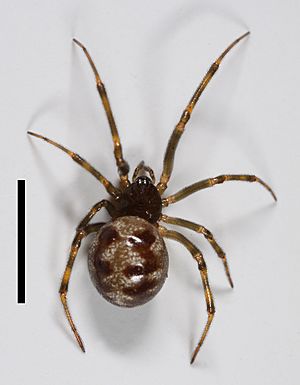Triangulate cobweb spider facts for kids
Quick facts for kids Triangulate cobweb spider |
|
|---|---|
 |
|
| Scientific classification | |
| Synonyms | |
|
The triangulate cobweb spider (scientific name: Steatoda triangulosa) is a common spider. It's also sometimes called the triangulate bud spider. You can often spot it because of the cool triangle-shaped pattern on its back!
What It Looks Like
Adult female triangulate cobweb spiders are about 3 to 6 mm long. That's about the size of a pencil eraser! They have a brownish-orange body part called a cephalothorax (where the head and chest are joined). Their legs are yellowish and thin, covered in tiny hairs.
The spider's round body, called the abdomen, is a creamy color. It has unique purply-brown zigzag lines running from front to back. This special pattern helps tell it apart from other similar spiders in its area.
What It Eats
The triangulate cobweb spider is a skilled hunter. It preys on many different small creatures. These include ants, even fire ants, and other spiders. It also eats pillbugs and ticks.
Interestingly, this spider helps control pests. It hunts other spiders that some people consider harmful. For example, it preys on the brown recluse spider.
Life Cycle and Web
The triangulate cobweb spider makes an egg sac from loosely woven silk. This sac is about the same size as the spider itself. Each sac holds around 30 eggs.
These spiders often live near windows or in dark places. They spend many hours building their webs. A well-made web is very strong and doesn't break easily. You might find dead insects caught in their webs. These can include stinkbugs, other spiders, and even wasps.
Where It Lives
The triangulate cobweb spider builds a special kind of web called a cobweb. This is an irregular tangle of sticky silk threads. Like other spiders that build webs, these spiders don't see very well.
They rely on vibrations in their webs to find food. Vibrations also warn them if larger animals are nearby. These spiders are not aggressive. If they bite, it's usually not dangerous unless someone has an allergic reaction.
S. triangulosa is found in many parts of the world. You can find it across North America, in southern Russia, New Zealand, and Europe. Scientists believe this spider originally came from Eurasia. It then spread to other places. This spider mostly lives inside buildings. It likes to build its webs in dark corners of houses and other structures.
See also
 In Spanish: Steatoda triangulosa para niños
In Spanish: Steatoda triangulosa para niños

